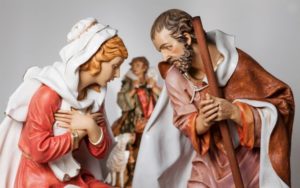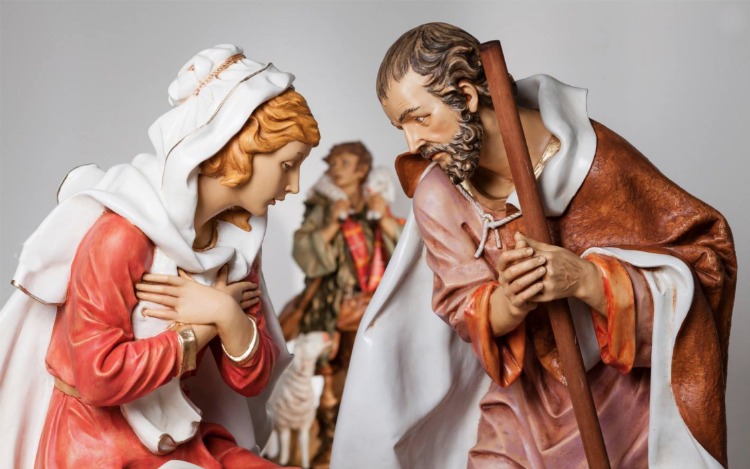
Central idea: The Birth of Christ. Doctrine: Holy images. Practical application: Contemplate the sacred images of Christmas.
To view lectionary 16, click here
Central Idea: The Birth of Christ
Reading 1 Is 52:7-10
How beautiful upon the mountains
are the feet of him who brings glad tidings,
announcing peace, bearing good news,
announcing salvation, and saying to Zion,
“Your God is King!”Hark! Your sentinels raise a cry,
together they shout for joy,
for they see directly, before their eyes,
the LORD restoring Zion.
Break out together in song,
O ruins of Jerusalem!
For the LORD comforts his people,
he redeems Jerusalem.
The LORD has bared his holy arm
in the sight of all the nations;
all the ends of the earth will behold
the salvation of our God.
- God himself was the King of Israel, but the children of Abraham so often in practice rejected their Lord’s kingship. They even asked for a human king, and after Saul, God gave then David and David’s line. Now in Jesus Christ, God’s children have a King in the line of David who is both God and man.
Responsorial Psalm Ps 98:1, 2-3, 3-4, 5-6
R. All the ends of the earth have seen the saving power of God.
Sing to the LORD a new song,
for he has done wondrous deeds;
his right hand has won victory for him,
his holy arm.The LORD has made his salvation known:
in the sight of the nations he has revealed his justice.
He has remembered his kindness and his faithfulness
toward the house of Israel.All the ends of the earth have seen
the salvation by our God.
Sing joyfully to the LORD, all you lands;
break into song; sing praise.Sing praise to the LORD with the harp,
with the harp and melodious song.
With trumpets and the sound of the horn
sing joyfully before the King, the LORD.
- To use Isaiah’s words, the Lord began “restoring Zion” and “bared his holy arm” in the person of a baby. His sentinels the angels, shepherds, and Magi announced his arrival. He brings the glad tidings of salvation from sin and death not just for the Jews but for every human being.
- Although God’s salvation occurred two thousand years ago, we discover it and experience it in our own generation. And so we join with the heavenly host of angels who sang to the shepherds that first Christmas night.
Reading 2 Heb 1:1-6
Brothers and sisters:
In times past, God spoke in partial and various ways
to our ancestors through the prophets;
in these last days, he has spoken to us through the Son,
whom he made heir of all things
and through whom he created the universe,
who is the refulgence of his glory,
the very imprint of his being,
and who sustains all things by his mighty word.
When he had accomplished purification from sins,
he took his seat at the right hand of the Majesty on high,
as far superior to the angels
as the name he has inherited is more excellent than theirs.For to which of the angels did God ever say:
You are my son; this day I have begotten you?
Or again:
I will be a father to him, and he shall be a son to me?
And again, when he leads the firstborn into the world, he says:
Let all the angels of God worship him.
- The savior God the Father sent to earth is not just a perfect man—which might have been enough—but he is, even more, the Son of the Father. In theological language, He is the Second Person of the Blessed Trinity sharing completely in the Divine Nature; He is the eternally begotten Son.
Alleluia
A holy day has dawned upon us.
Come, you nations, and adore the Lord.
For today a great light has come upon the earth.
- The Light of the World appeared to men’s eyes on the first Christmas as a baby. He had been hidden from sight for nine months as a fetus, before as an embryo, even before as a zygote. Then later he could be seen as a child, an adolescent, and a man.
Gospel Jn 1:1-18
In the beginning was the Word,
and the Word was with God,
and the Word was God.
He was in the beginning with God.
All things came to be through him,
and without him nothing came to be.
What came to be through him was life,
and this life was the light of the human race;
the light shines in the darkness,
and the darkness has not overcome it.
A man named John was sent from God.
He came for testimony, to testify to the light,
so that all might believe through him.
He was not the light,
but came to testify to the light.
The true light, which enlightens everyone, was coming into the world.
He was in the world,
and the world came to be through him,
but the world did not know him.
He came to what was his own,
but his own people did not accept him.But to those who did accept him
he gave power to become children of God,
to those who believe in his name,
who were born not by natural generation
nor by human choice nor by a man’s decision
but of God.
And the Word became flesh
and made his dwelling among us,
and we saw his glory,
the glory as of the Father’s only Son,
full of grace and truth.
John testified to him and cried out, saying,
“This was he of whom I said,
‘The one who is coming after me ranks ahead of me
because he existed before me.’”
From his fullness we have all received,
grace in place of grace,
because while the law was given through Moses,
grace and truth came through Jesus Christ.
No one has ever seen God.
The only Son, God, who is at the Father’s side,
has revealed him.
- Through the Word, the Second Person of the Blessed Trinity, all things in creation, that is, in this material universe, were made.
- But this Word is also a second creation. John calls him the Light of the World. He is a second creation in the sense that the Word became flesh, that is, the Second Person of the Blessed Trinity assumed a full human nature, with a human rational intellect and will and a human body with its desires and vulnerabilities. He was like us in every way but sin.
- Through Him every human being can become not just a child of this universe but a child of God.
- Through Moses, God the Father gave the Jewish people the Law, the guide for moral living. Through Jesus Christ, God the Father gives the whole human race grace and truth so we can become children of God.
- This gift is given to us through the God-Man Jesus Christ, born in Bethlehem, wrapped in swaddling clothes and laid in a manger
Doctrine: Holy images
- Christianity, specifically Catholicism and Orthodoxy, is a religion of images. As St. John Damascene, the champion who defended sacred art against the iconoclasts, said, “Previously God, who has neither a body nor a face, absolutely could not be represented by an image. But now that he has made himself visible in the flesh and has lived with men, I can make an image of what I have seen of God … and contemplate the glory of the Lord, his face unveiled” (CCC 1159).
- “Christian iconography expresses in images the same Gospel message that Scripture communicates by words. Image and word illuminate each other.” The Second Council of Nicaea declared, “we preserve intact all the written and unwritten traditions of the Church which have been entrusted to us. One of these traditions consists in the production of representational artwork, which accords with the history of the preaching of the Gospel. For it confirms that the incarnation of the Word of God was real and not imaginary, and to our benefit as well, for realities that illustrate each other undoubtedly reflect each other’s meaning” (CCC 1160).
- Further, that council said, “Following the divinely inspired teaching of our holy Fathers and the tradition of the Catholic Church (for we know that this tradition comes from the Holy Spirit who dwells in her) we rightly define with full certainty and correctness that, like the figure of the precious and life-giving cross, venerable and holy images of our Lord and God and Savior, Jesus Christ, our inviolate Lady, the holy Mother of God, and the venerated angels, all the saints and the just, whether painted or made of mosaic or another suitable material, are to be exhibited in the holy churches of God, on sacred vessels and vestments, walls and panels, in houses and on streets” (CCC 1161).
- Thus, the Church has given us, and defends, sacred art.
- The creation of beautiful representations of nature, of human beings, and of human artifacts is deeply human. This is why the Christian West could rediscover, cherish, and further develop the art of the ancient Greeks. Any culture that destroys real works of art or which produces ugliness in the name of art is deeply inhuman.
- But back to sacred art and Christmas: “Sacred art is true and beautiful when its form corresponds to its particular vocation: evoking and glorifying, in faith and adoration, the transcendent mystery of God – the surpassing invisible beauty of truth and love visible in Christ, who ‘reflects the glory of God and bears the very stamp of his nature,’ in whom ‘the whole fullness of deity dwells bodily.’ This spiritual beauty of God is reflected in the most holy Virgin Mother of God, the angels, and saints. Genuine sacred art draws man to adoration, to prayer, and to the love of God, Creator and Savior, the Holy One and Sanctifier.” (CCC 2502)
Practical application: Contemplate the sacred images of Christmas
- A great custom for the home is to have a nativity scene you take out and display each Christmas. Many families set up their nativity scene early but don’t put the baby Jesus in the manger until Christmas. This is one way to form the Christian imagination of your children and yourself.
- Some Catholics have the custom of doing their mental prayer in front of a Nativity scene during the Christmas season. In this way, images of the Holy Family, the shepherds and animals, and the Magi, and the stories we recall from the Infancy Narratives in Matthew and Luke, and the theological concepts like the Incarnation and Christ’s kenosis (self-emptying) provide rich food for thought and conversation with Our Lord.
- Christmas cards with sacred scenes are another way to honor Christ’s incarnation and to do apostolate with those we send them to.
- Many Christmas cards that depict the Madonna and Child can be framed and serve as permanent reminders of the human face of God throughout the year.

Leave a Reply